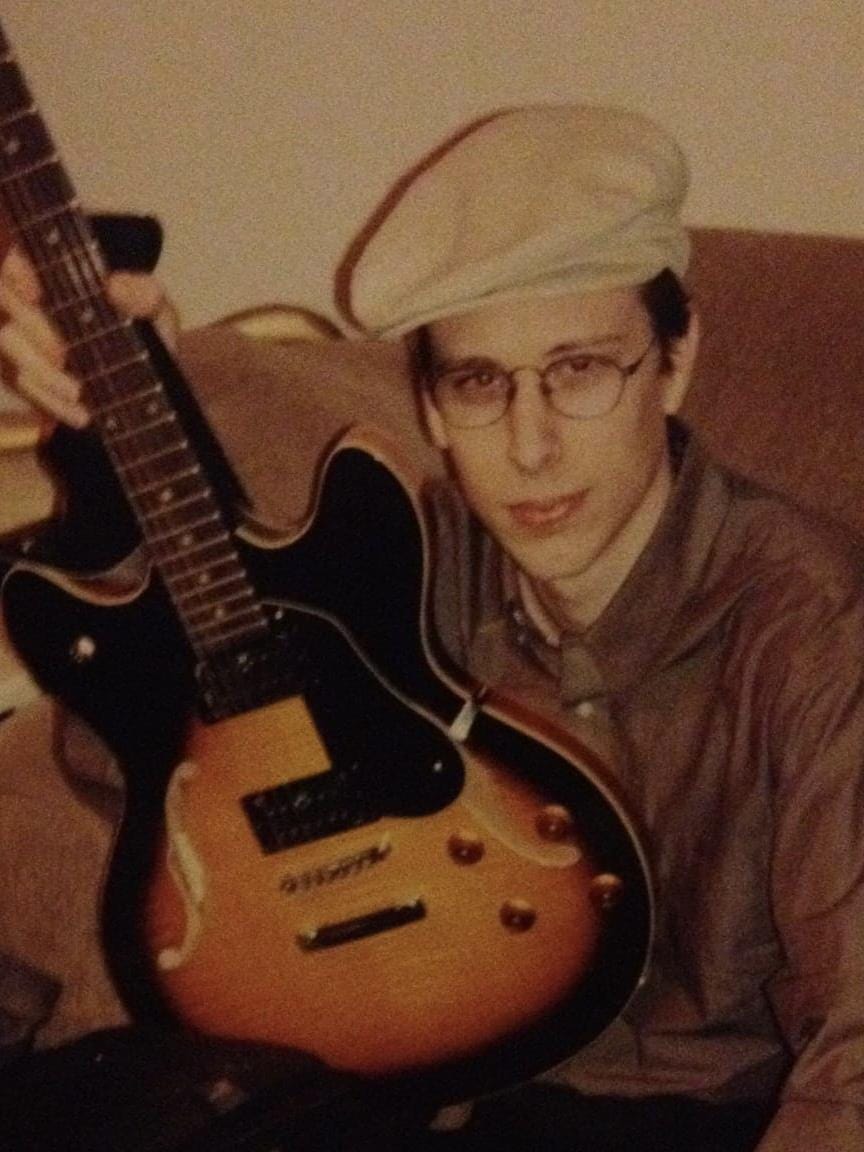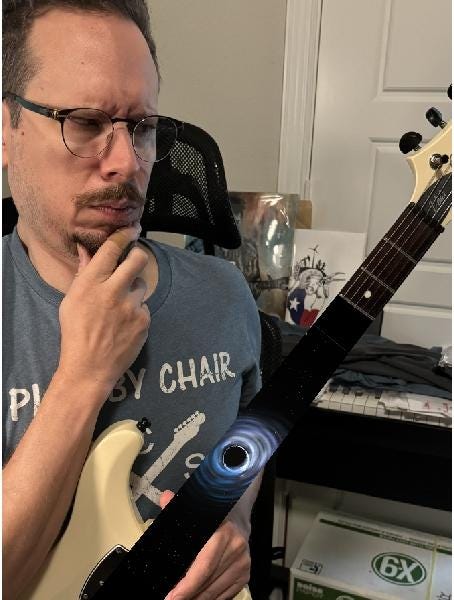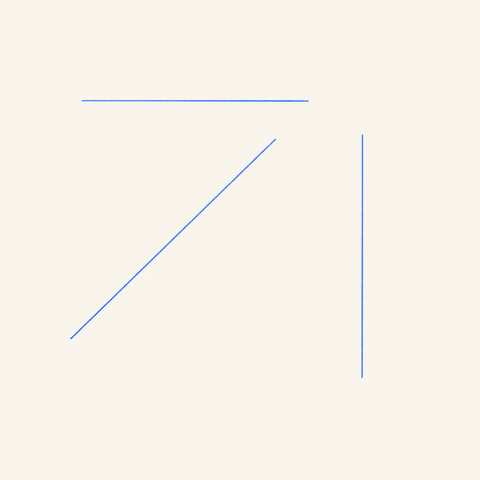Hey, Scoob here! I’m still in Japan, but I hope you enjoy this great guest post from Jeb on his journey with the guitar. There are a million ways to climb the mountain of music, and everyone needs to find their own! :) Enjoy! - Scoobert Doobert
—
I’m a terrible guitarist. Perhaps I should be a little more precise by saying I’m not a natural guitarist.
I’ve met players who appear to have just picked up the instrument, listened to their ear and played. It’s not as if we haven’t spent our lives listening to music. We know the rules in our subconscious. We know what notes sound good together and what notes sound dissonant. No doubt these players learned something of chords and scales, but they had an intrinsic concept of what sounded good to them and trusted themselves. Jimi Hendrix would probably fall into this category.
Grueling Piano
Oh, what I wouldn’t give to just trust myself. Instead, playing music has been like pulling my own teeth out with a rusty capo. Like many, I’ve always had the passion. My journey started in childhood with piano lessons. Good old Mr. C tried to teach me how music worked and how to read notation. None of it worked for me. Later on my mother would sit beside me and demonstrate how to play a piece note by note. I learned to play Greensleeves like this, finally graduating to Für Elise.
It was a grueling, slow process, and I had to play the pieces often to just remember them. I don’t think I ever reached the point of playing the songs well. Worse, I quickly found it wasn’t what I really wanted to do.
Music Was Baffling
What I really wanted was to understand how the music I was playing actually worked, so I could create my own.
I knew nothing of scales and the chords used in the few pieces I had learned. How the composer chose the notes was completely beyond me. Over the years, I learned various pieces on piano, but always hit the same problem that while I enjoyed playing songs I’d learned — my soul wanted to create, not replicate.
Reverse Engineering
Please understand, this is nothing at all against replication. The world is full of extraordinary players who play pieces in extraordinary ways. They bring their own soul and personality to a song and make it their own. I, however, couldn’t really connect to it that way. My brain wanted to understand how the composition process worked and replicating simply didn’t trigger the necessary connections to occur in my head. I had to reverse engineer music for myself because I couldn’t seem to understand what anyone else was trying to explain.
Worse Than Piano
When I started trying to play guitar at about age 19, I once again went through the stages. I had a few guitar lessons, but my teacher’s approach didn’t work for me. I learned how to strum chords and memorized a few solos from VHS tapes I bought at the music store. (Yes, I’m that old.)
I wanted to play blues like Eric Clapton, so I tried to read tablature, but never connected with that either. I learned a few box shapes, one pentatonic, one diatonic, but seeing the fretboard as little chunks of four frets confused me even more. The piano had been a straight line of notes from end to end, while the fretboard was a black hole of seemingly random notes:
Out of Reach
Music was this abstract concept which always drifted just beyond my grasp. Something geniuses and natural musicians could do, but I couldn’t. The shape of it was always hazy and out of reach. So, after trying to play saxophone, guitar and piano, I gave up for a while.
Helpful Arpeggios
It wasn’t until a friend of mine taught me how to arpeggiate chords on piano into melodies that I really started understanding how to compose. He would basically use the notes from inside of a chord progression to shape a melody.
This was something which made much more sense to me. I could play something using the notes of one chord, then repeat it on the next chord, then on the next. I learned to vary the phrase from chord to chord, then how to make phrases using the second, skipping the root.
But I still had no idea what I was doing. I didn’t even know what a “second” was. Just by understanding how those notes fit together, I could make something of them. No doubt much of this seems obvious to some players and overcomplicated to others. But I had to go through those stages just to learn how to make a melody. I have to break things down to their smallest components to understand most things I do.
Black & White
My biggest problem on piano was I still couldn’t understand the shape of things. Literally. Each chord on a piano is a slightly different shape visually because of the black keys. I could hold a chord, slide my fingers up between those black keys then slide my hand over a key to get the next chord.
This was really helpful, but it didn’t tell me which chords went together, or how they related to scales. The Circle of 5ths was gibberish to me back then and it only works for me now because I can see it on the fretboard through my system, but I digress.
Eventually, I stopped playing again.
Visual Differences
Years went by before I picked up the guitar once more. I had always connected to it in some ways easier than piano but didn’t know why. This time, I broke down the differences between guitar and piano. Piano was much simpler in note structure. There was only one key for every note. The notes ascended from left to right and I had finally figured out that if one stretched the keyboard out making all the black keys white, then it was just a continuous stretch of repeating notes. But with the black keys, the scale and chord shapes were visually still different.
More (and Less) Complex
The guitar, on the other hand, was significantly more complex in some ways, but simpler in others. Each string was like a stretched out piano. The notes ascended from low to high, but there were no black keys making road bumps along the way. It would have been so much visually simpler if there hadn’t been six of those strings next to each other. Unlike piano, most of the notes were repeated across the neck, further complicating note choices.
Overwhelming Box Shapes
Scales were the hardest part. The horizontal approach (boxes) still made everything chaos to me and the B string was the bane of my existence. Each of the five box shapes were different and to understand the fretboard as a whole, you had to memorize and connect them into a lattice work of random gibberish. I couldn’t discern the overall pattern even though I knew others had after years of practice. The process was too overwhelming for my brain.
Finding the Key
It was then I encountered an extended scale. The scale worked diagonally instead of horizontally and the fretboard snapped into focus like magic. Instead of random shapes, I started seeing a single shape which moved diagonally instead of horizontally. Suddenly, there was order to the chaos.
I found a single shape, (that I call the chair shape) within that scale, which repeated infinitely in stripes down the fretboard — connecting everything.
Each shape contained the same notes in the same position, so anything I played on one shape, I could play on the next in another octave.
Order Within Chaos
Now I began to understand why guitar attracted more improvisers, while piano seemed so well suited to playing sheet music. The guitar was, in fact, genius — if one looked at it as a repeating grid.
Without the black notes, anything you did in one place on the neck could be slid anywhere else, using the same shape!
An A chord shape could BECOME a D# chord or a G chord by simply moving it around. You just have to put the same shape into a different place. And a scale could be moved in the same way! You only had to know the root to know the whole scale. I even came to grips with the B string and came to love the variation it provided. The guitar was chaotic from one angle, but perfectly ordered from another.
Guitar Structure Creates Patterns
The simple answer to my dilemma is that notes on the guitar are actually laid out diagonally, not horizontally. There are many advantages to horizontal playing because it does bring the notes closer together, but it doesn’t make the structure as obvious. The guitar is already patterns. Patterns which are music. Not only scales and chords, but keys.
Just knowing the root, you can know the entire scale (major, minor, or you can skip looking at them as modes altogether), all the chords associated with the root like in the CAGED system, and also every chord associated with the notes in the scale. The Circle of Fifths is right there as well, and you can come up with chord progressions on the fly. It’s all there, laid out over strings and frets if you just squint your eyes the right way.
Visual Theory
For me, the world changed that day. I realized for the first time that in order to understand how music functioned, I had to visualize theory on the fretboard. I needed to see it, so I could stop thinking about it consciously. It simplifies the mental processing, like zipping a file on your computer.
What’s Your Journey?
I am still a terrible guitarist in many ways! After all these years of having to figure out how to see music from the ground up, I still feel like a child trying to understand what the world is made of. When I look at truly “natural musicians” like Jimi Hendrix or fantastic technical players like Joe Satriani and Joe Pass, or players defying the very reality of music like Allan Holdsworth, I still feel like I barely have the right to touch the instrument:
The fact that I have to break down things in such excruciating detail in order to play is still the most aggravating aspect of my own musical journey. But it is indeed my journey. And our experiences are all different. Everyone who has ever played has had their own challenges. Understanding how notes fit together was mine.
While I don’t know if I will ever be a great player, I do hope my way of looking at the fretboard will be of use to others. They will no doubt take it to much greater heights and use it in ways I could never have imagined. Please enjoy my system.
Jeb
(Stick around for the 3rd installment of his 3 part guest series next week.)
You can learn more about Jeb’s system at: MusicalChairSystem.com
—
For an accompanying chair system discussion on a complimentary medium make a note of Jeb’s upcoming appearance on the Love Music More podcast hosted by Scoobert Doobert and produced by Beformer on Tuesday October 29th. Music on!













